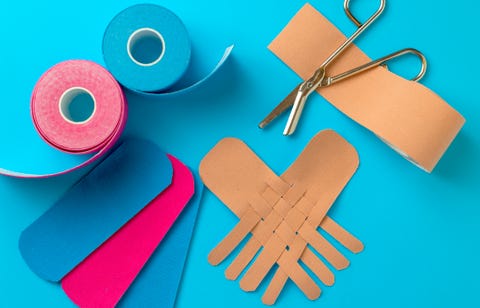How Kinesio Tape Actually Works
Your Personal PT, Rachel Tavel, is a Doctor of Physical Therapy (DPT) and Certified Strength and Conditioning Specialist (CSCS) at Shift Wellness in NYC, so she knows how to get your body back on track when it’s out of line. In this weekly series, she gives you tips on how to feel better, get stronger, and train smarter.
Around the time of the 2004 Athens Olympic Games, colorful strips of tape strategically stuck in various ways across athletes’ bodies started popping out on broadcast competitions. The bright, sticky stuff reappeared in the 2008 Beijing Olympics, drawing even more attention. Volleyball players reached for balls with bright pink and black tape stretched in criss-crossing patterns around their shoulders and swimmers appeared with it strewn about their backs. For those outside athletics, the application was mystifying: What was this tape all about?
Kinesio Tape (KT) is a brand of elastic therapeutic tape used in rehabilitation practices and sports to reduce pain and disability from injury. The goal is to help anyone from an elite athlete to a weekend warrior (or even grandma and grandpa) to move better. The brand is actually one of many different types of kinesiology tape, and probably the most well known—like Kleenex for tissues.
Originally developed in 1979 by Japanese chiropractor, Dr. Kenzo Kase, the goal of the tape was to provide support while allowing movement and promoting healing of soft tissue injuries. Different application techniques serve different purposes, so depending on what is going on in your body, a trained and certified practitioner and user of KT will know which approach is right for you.
The tape itself is made up of a gentle cotton fiber strip that has one medical grade adhesive acrylic side that adheres to skin (and yes, hair… brace yourself for the removal part). It’s actually designed to mimic the elasticity of human skin. The material is latex free, hypoallergenic, water resistant and designed to stay stuck to the body through showers, sweat and all that life throws at you. The stuff should stick for three to five days, but then you’ll need to reapply.

TutyeGetty Images
By lifting the top layer or skin ever so slightly, KT creators claim the adhesive quality of the tape helps promote lymphatic drainage and promote circulation, therefore reducing inflammation and pressure on the underlying tissue. The technique may even have the ability to help relax or stimulate muscles.
Depending on why you are using the tape, knowing the underlying anatomy of the body is critical for proper application. Different amounts of stretch and different attachment points are strategically selected to obtain the desired effects. Oftentimes the taping patterns you see on the surface of the skin will match up with where tendons attach to bones, where muscles are injured, or where swelling persists around a joint. But one thing is consistent: the taping is applied in a way that still allows you to move. Unlike other materials that completely limit movement, KT is not strong enough to completely immobilize a joint—and that is deliberate, in this case.
While the tape might not look like it is doing anything on the surface (except making you look extra sporty and cool), research suggests that it actually does what it claims to do. One small study, for example, showed KT is effective at improving muscle torque and strength in the quadriceps muscles of female athletes and another much larger study showed it is effective at reducing neck pain and improving mobility.
The effect of using kinesio tape is more neuromuscular than musculoskeletal, meaning it affects proprioception or your body’s awareness of itself in space rather than just mechanically distorting the tissue. In other words, the tape can help to improve signaling between the sensory receptors in the body and the brain so your brain has a better response to what is happening in the environment.
Don’t believe me? That’s okay. I was once a doubter, too. But after smacking some tape on and seeing results, I’m now a believer and a fan. Next time you have an injury, ask your PT if KT is appropriate for you and make your own conclusions. The pain of ripping it off when you’re done might just be worth it.

microgenGetty Images
When to use it: A certified physical therapist can help determine when it is appropriate to use KT in your treatment, but here are a few common uses of KT:
When using Kinesio Tape:

Source: Read Full Article
